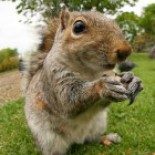Snowshoe hare catching in the Yukon
Gallery: Click on the first picture and Sophia will walk you through her fieldwork.

I am working in southwestern Yukon where I am running experiments with wild-caught snowshoe hares and monitoring their populations.

Yukon weather can be unpredictable any month of the year.

Trapping in winter means being prepared to deal with temperatures ranging anywhere from -28 to -2C, warm sunny days to howling winds, blustery storms, and waist deep snow.

I catch hares around Kluane Lake using live-traps, baited with alfalfa and a little bit of apple.

Because hare numbers are low, we take advantage of snow tracks to identify areas of high hare activity ready for the spring when we revisit the sites with traps.

Any hares caught are given an identifying ear tag, weighed, measured, and sexed before being released.

This winter we also radio-collared several females so we could locate them in the spring.

My fieldwork is based out of the Kluane Lake Research Station (KLRS), which is 220 km northwest of Whitehorse, Yukon.

In the wintertime, conditions in the field station are rustic—we eat, sleep, and work in a single building.

We melt snow for dishwater, and pull our beds up to the stove to stay warm.

The best parts of spending time at KLRS is having 19 hours of daylight, and experiencing the Kluane Lake ice break up in the spring.

This spring we have caught pregnant females and housed them in outdoor enclosures we constructed.

We already know that when a pregnant hare is stressed by increased predator exposure, she has fewer, smaller, lighter babies.

But what effect this inherited programming has on her young’s behaviour and survival has yet to be looked at.

This is what I am studying using a trained dog and bird models as stressors to vary the amount of predator exposure these hares experience.

By varying the amount of predator exposure, we can measure the impact of high verses low exposure on the young’s brain organization and function, as well as their behaviour and survival.

Otis, my dog, makes a great field assistant!

This is my first of three years of fieldwork, so hang tight for results.

Sophia Lavergne is a graduate student in the department of Ecology and Evolutionary Biology. Along with Professor Rudy Boonstra and Patrick McGowan in the department of Cell Systems Biology at University of Toronto, Scarborough, she is studying maternal programming of young as a result of predator-induced stress in the snowshoe hare–a keystone species of the boreal forest. This programming of the young may be influenced by epigenetic changes, heritable changes in the DNA that determine which genes are turned on and off without changing the underlying DNA sequence itself.




























